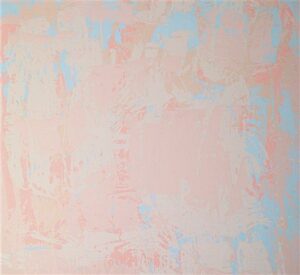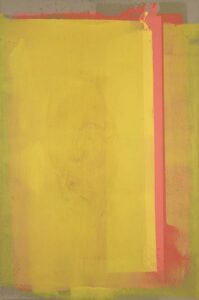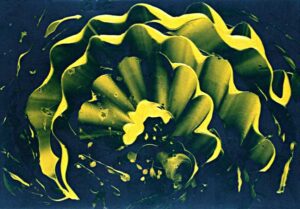Not many art lovers know Darby Bannard, even though he lived a long time and accomplished many things. In the late fifties, Bannard and his friend Frank Stella inspired themselves to make pictures that were very direct, to the point not many recognized them as “paintings” until almost 10 years later. In a letter to me he said the rules they followed were “the work should be very simple, flat, symmetrical and inexpressive.”( 1 ) The result, for Bannard, were pictures that can be described as direct, “in your face”.

Clement Greenberg chose three of them for his Post Painterly Abstraction show in 1964, and soon after that, Bannard’s career began to take off, as his “non-paintings” came into acceptance as the good pictures they were. He became a contributing editor for Artforum, was written about, sold well, and was collected by major museums.
Presciently, while Clement Greenberg was looking at Bannard’s simplified work for his exhibition, he pointed to one of Bannard’s 1958 “kid pictures” in the style of “10th Street Abstraction”, a style Greenberg was on record as disliking. Then he said “this is what you will be doing 10 years from now” (2). Bannard thought Clem was “full of shit” (3) at the time, but that is exactly what happened.
A few years after Post Painterly Abstraction, Bannard revisited the loose paint of Abstract Expressionism. Where Bannard once carefully brushed coat after coat of precisely selected color into hard edged containers, he now flipped baby diapers soaked in paint onto his canvas. Freer? Yes. But freer at a cost. Like in life, progress in painting has its ups and downs. The new stuff didn’t nail the issue like what came out of his collaboration with Stella and their hard-nosed theories that had inspired them to create “minimalism” before Minimalism existed.
Olitski’s 1972 show at Rubin surprised even Bannard.(4) While they both were departing company from the growing crowd of fashionistas, Olitski’s new pictures were better than anyone’s, including Bannard’s. Such an experience could defeat an artist of less talent and ambition, but not Bannard. If Olitski’s pictures cut into his ego, they did not destroy his nerve. They were a provocation to paint better and be harder on himself—inspiration of the most effective sort.

Ultimate ambition—to be willing to do anything to get better—is tested when an artist confronts another artist’s work and sees that it is better. A pseudo-ambitious artist runs from the experience, putting as much distance between himself and his competition as possible. Taking from someone who is better than you is treacherous. It can make you derivative in the eyes of the art world. It is also absolutely intrinsic to the transmission of high art, as the best stuff is renewed by its influence on other artists, handed from one artist to another in a continuous line. If there are breaks, quality usually declines. Bannard took what he needed from Olitski, shamelessly.
Bannard saw that he needed to be more direct with his paint than flipping diapers. He built his new painting around a strategy of pushing paint, one which permitted the physical properties of paint itself to decide how the picture would go, and to decide how the picture comes to its unity. Control would be achieved while the paint was moving, or it would not be achieved at all.
Sampson, a 1972 picture, was one of the first in a series that showed the fullness of Bannard’s new direction. They brought mixed reactions. Many said they borrowed too much from Olitski. However, what counts is that the series was better than anything since his early hard edged pictures.

Bannard’s Olitski influenced painterliness led to many magnificent pictures in the early eighties, the decade when he matured. They are called the “Scallops”: Tintan, Baylor’s Eye, and Tridacna, among others. The structure of his Scallops left Euclidean severity behind in favor of Rococo lush, but nonetheless remained loosely geometric, regular, and above all as simple as they are supple, the simplicity that he and Stella so dearly prized in the 50s and 60s. He showed that painters could pump lushness into Minimalism if “geometric purity” was replaced with directness and clarity. The pictures show that Minimalism, at its root, was about reduction to the clear statement, not geometry, not theoretical “content”, and certainly not restrictions picked, more or less, out of thin air. His color went from restrained to vibrant, almost violently so at times. And his surface went from “dry” to “wet”, all without giving up any of the simple clarity that he had achieved during his association with Stella. Clarity was intensified by letting the nature of his paint set its own boundaries.
The method of most of the pictures in the series was a simple “two-step” application of paint, each accomplished as a single layer, while some of the later ones involved three layers. They suggest that we might revise the conventional understanding of Minimalism, especially its relationship to geometry, for he is the only practitioner of the approach who took its clarity to a masterfully satisfying level of splendor and thick lavish sensuousness.
Each picture proclaims insistent unity. Seeing their paint as material is intrinsic to seeing the scalloped forms which arise at the edges of the scraped and pushed paint, because if you don’t see the paint, you don’t see the forms. Malerisch exists at their core, as a part of their substance. The paint, the form, and the content are all necessarily connected because they are each the same thing. But showing them at Knoedler’s in 1984 marked the end of the favorable response that Bannard once received from the ubiquitous and even more dominant establishment, which had decided that formalism, Clement Greenberg, abstraction, and malerisch belonged in the aesthetic wastebasket.
The pictures in that show upset commonly practiced taste because they put it to a test it could not pass, showing how flaccid it had become when faced with real art. The really bad art of the eighties, like David Salle’s, had numbed sensibility. Its capacity to feel was so compromised it turned away in anger, looking for something bad enough to cause pain, the only feeling it still experienced with any vividness. Its apparent love-affair with the “difficult” was a disguise for its inability to find excitement and feeling in truly beautiful things, a disguise for its essential laziness, and a way to conceal its love for the familiar.

The crowd in charge rejected the mature Bannard—now master Bannard—because the alternative would be to reject their own anesthetized response to serious art. Rejecting Bannard was not merely the easiest course of action, it was the only course which did not threaten their insistence that art must be overwhelmingly interesting, that it deliver a jolt so immediate and unmistakable that everyone forgets about taste, substituting the thrill of naughty outrage and smug “enlightenment” for the aesthetic feeling that was so far from their reach. This taste prefers art which is freakish, and therefore easy to talk about, over art which is good, and therefore difficult to explain.
Contemporary art since the early sixties has been extraordinarily permissive. This permissiveness gave rise to what Greenberg called “novelty art”. He thought it would not last long, but the combination of ersatz revolution and ease of understanding turned out to be very compelling. Greenberg admitted the new novelty stuff was titillating, a backhanded sort of compliment, but admission of value nonetheless. Titillation explains why his prediction it would not last long did not come true. With the 1973 auction of Robert Scull’s collection, “titillating art” demonstrated it was also a good investment.
Paint and masterful painterliness seem tame and “unoriginal” when compared to art that is based on titillation. No matter how many Bannards might be hung on the wall, it would be difficult to pay attention to them if the gallery were filled with the amplified sounds of a Vito Acconci masturbating somewhere nearby. Life, especially when it is taken to the extreme of the freakish, overwhelms art, when it serves up an engrossing dose of titillation. That this is true does not detract from art; it only points to art’s necessary distance from life as lived, and the subtlety of aesthetic experience. Taste is an acquired habit, one that takes some work to acquire, though its acquisition is among the most satisfying our species can undertake. Titillation works automatically; we are hard wired to respond to it. It is fun and, frankly, there is nothing wrong with it: I like it too. But it is not the same thing as experiencing something aesthetically – as Greenberg put it, “feeling like you are dancing three feet off the ground”.
In any profession, falling from repute is traumatic. In art, where ultimate value rests upon collective opinion expressed over the long run, a multi-decade downslide can destroy motivation, cut into nerve, and make an artist go in circles trying to recover what he once had. Or, it can temper some of his soft spots, making them hard, eliminating sentiment and fantasy, disciplining arrogance and ego into a cold and merciless view of his creative achievement. Whatever else happened to Bannard, he did harden. He was harder on himself and other artists. He expected more from everything he looked at, including his own stuff. This hardness nourishes great art.

Bannard was a critic too.(5) A good part of what went wrong with Bannard’s “career” can be traced to his writing. It seems inevitable that any artist who publishes at the same time he exhibits will be the subject of a special agenda which at times resembles an inquisition. Peter Plagens, Thomas Hess, Hilton Kramer, Charlotte Moser, Peter Robertson, and a host of others have commented on the relationship between Bannard’s writing and his art. In most cases, his art comes out on the short end. Moser’s 1974 review of Bannard’s retrospective at the Houston Museum of Fine Arts was the most quirky. She accused him of being “more an arbiter of taste than a shaper of vision” because he was then a contributing editor of Artforum.(6) She went on to say that the only reason he was given the retrospective was the support of “certain New York art chieftains”(7) who saw him as the conveyor of the values they had “shaped,” adding that he ought not think about his possible place in history, the implication being that his critical writing was leading him into this “error.” Everything she wrote reflects the attitude much of the art world takes toward any artist who writes.
On the contrary, there are no absolute values in art, which is one of the enduring insights of pluralism. The critic’s words are validated by art, not vice versa. The only useful activity of the critic is to point out work that is superior and distinguish it from that which is inferior. Artists, not critics, are the source of superior art.
The problem for artists who write is that middlebrow taste worships artists who surrender all intelligence, living at the edge of sanity in a Dionysian frenzy of “creative urges.” Few things are less “Dionysian” than making pretty pictures, but writing solid art criticism is one of them. Middlebrow expectations never came to grips with Bannard’s intelligence, especially when it stared them in the face from the pages of their favorite cultural publications. Artists aren’t supposed to speak, except in tongues. Bannard’s writing shows the depth of his education and rationality. He was not ashamed of being well read and letting it show. But it did not end there.
After many decades of living in obscurity as a professor of painting at the University of Miami, Bannard began showing again in NYC at Berry Campbell and Loretta Howard. They are respectable, upscale venues that specialize in modernist art. Berry Campbell’s original inventory of his work extended to 1981. Loretta Howard’s was even more limited. While Berry Campbell showed works from the seventies in a 2014 show, his second last exhibition—March, 2015—was devoted to his 1958-1965 early minimalist style work.

But just before Darby Bannard died, Berry Campbell agreed to a show of recent work. That show opened two weeks after he passed away October 2, 2016. But as late as July before the show was to open, he was unsure whether it would be accepted by those who still supported Modernism. He said: “I’m not sure anyone likes the recent work. It is not in the Olitski/color field category anymore, and those devotees what there are of them, are hesitant. I love them.”(8)
While the “Scallops” of the 80s brought the directness of Minimalism into a hotly painted series, the last two years brought back simple forms from his hard edged work into a virtual playground of color, paint in motion, and outright swagger, all of which dislodged them from their previous rigid positioning. They are a testament to the joy of painting and the joy painting brings to those who love it.
Darby’s health was compromised and he knew it. He used a cane and wheelchair, so he enlisted friends to help. Nor did he care when his efforts failed. He wrote me, “They are pure play and very difficult to bring off – I average about 20%.”(9) He had serious fun while he worked on them, hard as it was to make them succeed, and hard as it was to work inside the limits his health imposed. Thankfully, Berry Campbell focused the 2016 show on the last two years, with 14 of the 18 pictures coming from that period. And they now represent his estate.
I love these pictures too. Darby saved his best until last. Big Yellow (16-13) is one of the best of the best. While the “Scallops” plumbed the foundations of minimalism while pushing paint with a vengeance, the last series, which has no moniker, included everything he had explored in an outpouring of pure joy and peace. He had nothing left to lose and that opened him to a freedom he had not expressed before, the freedom to love paint, to love color, to love form, to love painting, and to forget everything else. The joy of painting, indeed.
John Link
FOOTNOTES
1. Bannard, Darby. Message to the author. July 5, 2016. E-mail. 2. Ibid. 3. Ibid. 4. Bannard wrote about Olitski and his superiority in "Quality, Style, and Olitski," Artforum, June, 1972, pp. 59-64. 5. The Walter Darby Bannard Archive web site presents all of Bannard’s writing from 1966 through 2009. (http://wdbannard.org/index.html) 6. Moser, Charlotte. "Bland, boring and Bannard," Houston Post, Sunday, June 9, 1974, p. 12 7. Ibid. 8. Ibid. 1. 9. Ibid. 1.

Thank you John for your article on Darby Bannard and reminding me that this is what we all strive for: “He had nothing left to lose and that opened him to a freedom he had not expressed before, the freedom to love paint, to love color, to love form, to love painting, and to forget everything else. The joy of painting.”
You are welcome Will. Pleasure and joy is what keeps art alive and in motion. Darby provided us with a fine example of how the hedonism of art manages this.
After reading your brilliant article (the title was my starting point, as one who appreciates joy), I became curious to know more about Darby Bannard and discovered that a new exhibition of his work will be held at Berry Campbell in New York from November 15 – December 21, 2018. Without your article I wouldn’t have known anything about him, so thank you for this.
Thanks Florence. A lot of art criticism is, well, critical. I certainly have written my share of rants about art and art systems that I didn’t like. But what we don’t like is NOT why we keep coming back to art. And I question whether dwelling on what we don’t like is worth all the attention it gets as a result. So I am glad I turned you on to Darby Bannard and that you are finding something to enjoy in his work.
Hi John, it was lovely of you to answer me, and you are very talented with words. Try as a I may, I cannot grasp the meaning of your sentence, ” But what we don’t like is NOT why we keep coming back to art.” What do you mean here?
I mean that the bad stuff does not keep us coming back to art, despite the fact it can be fun, in a limited way, to write about and especially to whine about. The good stuff is what sustains us.